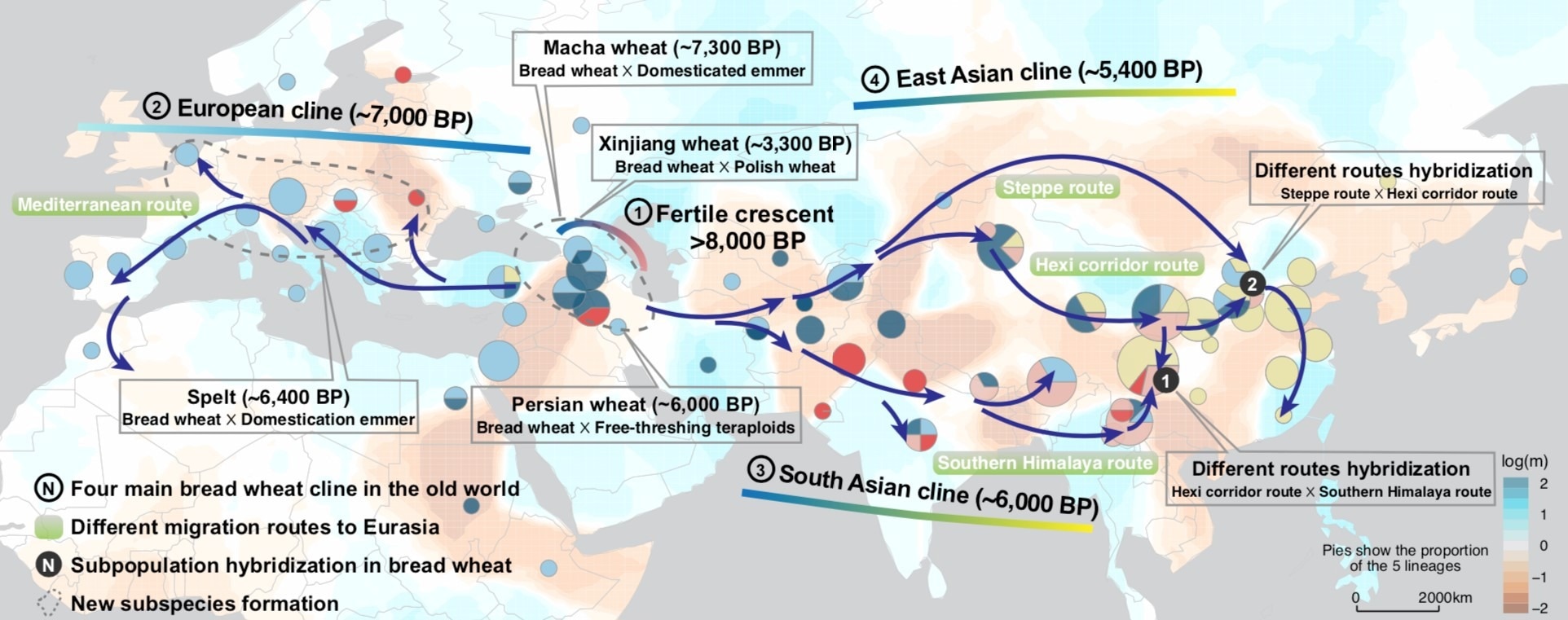Over 35% of the world’s population is nourished by wheat, which includes bread wheat and its relatives. Wheat has been cultivated for more than 10,000 years, beginning with the “Neolithic Revolution,” and is one of the earliest ancient crops to emerge in the Fertile Crescent.
 Fig. 1. Trans-Eurasian expansion of bread wheat. Image Credit: IGDB
Fig. 1. Trans-Eurasian expansion of bread wheat. Image Credit: IGDB
It is regarded as a transformative force in human history. The demographic history of wheat is still unknown, despite its economic significance and close connection to humans.
Researchers from the Institute of Genetics and Developmental Biology of the Chinese Academy of Sciences (CAS) under the supervision of Fei Lu have revealed the evolutionary history of wheat during the Holocene in a recent study that was published in Nature Plants.
In this research, Xuebo Zhao, Yafei Guo, and members of Lu’s team collected the whole-genome sequences of 795 wheat accessions from six species and 25 subspecies of the genera Triticum and Aegilops (wheat). After that, using around 78 million single-nucleotide polymorphisms, they created a genus-level genetic variation map of wheat (VMap 1.1).
The researchers discovered that bread wheat originated from a polyploidization event near the Caspian Sea’s southwest coast using demographic modeling of the genomic data. Bread wheat, on the other hand, had a delayed speciation process that lasted roughly 3,000 years as a consequence of continued gene flow from its relatives.
Bread wheat then expanded fast over Eurasia, eventually reaching Europe, South Asia, and East Asia between 7,000 and 5,000 years ago.
The researchers discovered that three independent loss-of-function mutations in a prime flowering time gene (Ppd-D1), bestowing early flowering phenotypes, assisted bread wheat to adapt to Europe, East Asia, and South Asia, respectively. The trans-Eurasian dispersal shaped a generally diverse but occasionally convergent bread wheat adaption landscape.
Crop relatives are useful for producing robust crops in a changing climate. Yet because of dietary changes and susceptibility to future climate change, the researchers found an alarming reduction in the population size of some of bread wheat’s most important relatives.
For instance, over the past 2,000 years, the number of diploids and tetraploids in Triticum has decreased by 82%. This discovery emphasizes how crucial it is to safeguard and conserve wheat biodiversity.
As a result, this study provides an extensive collection of demographic models that explain the population history of bread wheat and related species and have prepared the way for a thorough analysis of the genetic factors that influence wheat adaptation.
These results are expected to be beneficial to future attempts to produce climate-resilient crops and protect wheat biodiversity.
Source:
Journal reference:
Zhao, X., et al. (2023). Population genomics unravels the Holocene history of bread wheat and its relatives. Nature Plants. doi.org/10.1038/s41477-023-01367-3